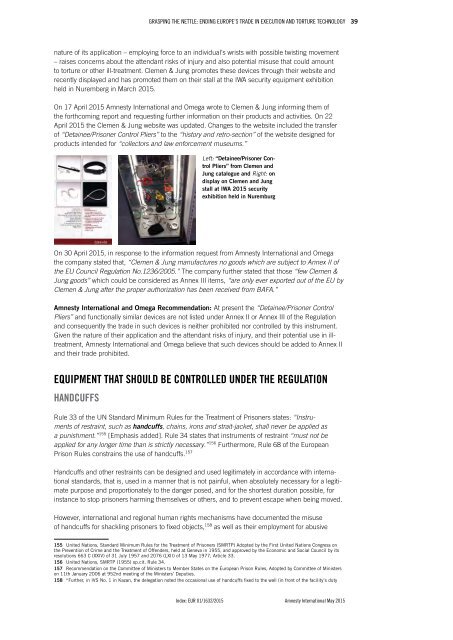Grasping the nettle
1Gsbbd6
1Gsbbd6
Create successful ePaper yourself
Turn your PDF publications into a flip-book with our unique Google optimized e-Paper software.
<strong>Grasping</strong> <strong>the</strong> <strong>nettle</strong>: Ending Europe’s Trade in Execution and Torture Technology 39<br />
nature of its application – employing force to an individual’s wrists with possible twisting movement<br />
– raises concerns about <strong>the</strong> attendant risks of injury and also potential misuse that could amount<br />
to torture or o<strong>the</strong>r ill-treatment. Clemen & Jung promotes <strong>the</strong>se devices through <strong>the</strong>ir website and<br />
recently displayed and has promoted <strong>the</strong>m on <strong>the</strong>ir stall at <strong>the</strong> IWA security equipment exhibition<br />
held in Nuremberg in March 2015.<br />
On 17 April 2015 Amnesty International and Omega wrote to Clemen & Jung informing <strong>the</strong>m of<br />
<strong>the</strong> forthcoming report and requesting fur<strong>the</strong>r information on <strong>the</strong>ir products and activities. On 22<br />
April 2015 <strong>the</strong> Clemen & Jung website was updated. Changes to <strong>the</strong> website included <strong>the</strong> transfer<br />
of “Detainee/Prisoner Control Pliers” to <strong>the</strong> “history and retro-section” of <strong>the</strong> website designed for<br />
products intended for “collectors and law enforcement museums.”<br />
Left: “Detainee/Prisoner Control<br />
Pliers” from Clemen and<br />
Jung catalogue and Right: on<br />
display on Clemen and Jung<br />
stall at IWA 2015 security<br />
exhibition held in Nuremburg<br />
On 30 April 2015, in response to <strong>the</strong> information request from Amnesty International and Omega<br />
<strong>the</strong> company stated that, “Clemen & Jung manufactures no goods which are subject to Annex II of<br />
<strong>the</strong> EU Council Regulation No.1236/2005.” The company fur<strong>the</strong>r stated that those “few Clemen &<br />
Jung goods” which could be considered as Annex III items, “are only ever exported out of <strong>the</strong> EU by<br />
Clemen & Jung after <strong>the</strong> proper authorization has been received from BAFA.”<br />
Amnesty International and Omega Recommendation: At present <strong>the</strong> “Detainee/Prisoner Control<br />
Pliers” and functionally similar devices are not listed under Annex II or Annex III of <strong>the</strong> Regulation<br />
and consequently <strong>the</strong> trade in such devices is nei<strong>the</strong>r prohibited nor controlled by this instrument.<br />
Given <strong>the</strong> nature of <strong>the</strong>ir application and <strong>the</strong> attendant risks of injury, and <strong>the</strong>ir potential use in illtreatment,<br />
Amnesty International and Omega believe that such devices should be added to Annex II<br />
and <strong>the</strong>ir trade prohibited.<br />
Equipment that should be controlled under <strong>the</strong> Regulation<br />
Handcuffs<br />
Rule 33 of <strong>the</strong> UN Standard Minimum Rules for <strong>the</strong> Treatment of Prisoners states: “Instruments<br />
of restraint, such as handcuffs, chains, irons and strait-jacket, shall never be applied as<br />
a punishment.” 155 [Emphasis added]. Rule 34 states that instruments of restraint “must not be<br />
applied for any longer time than is strictly necessary.” 156 Fur<strong>the</strong>rmore, Rule 68 of <strong>the</strong> European<br />
Prison Rules constrains <strong>the</strong> use of handcuffs. 157<br />
Handcuffs and o<strong>the</strong>r restraints can be designed and used legitimately in accordance with international<br />
standards, that is, used in a manner that is not painful, when absolutely necessary for a legitimate<br />
purpose and proportionately to <strong>the</strong> danger posed, and for <strong>the</strong> shortest duration possible, for<br />
instance to stop prisoners harming <strong>the</strong>mselves or o<strong>the</strong>rs, and to prevent escape when being moved.<br />
However, international and regional human rights mechanisms have documented <strong>the</strong> misuse<br />
of handcuffs for shackling prisoners to fixed objects, 158 as well as <strong>the</strong>ir employment for abusive<br />
155 United Nations, Standard Minimum Rules for <strong>the</strong> Treatment of Prisoners (SMRTP) Adopted by <strong>the</strong> First United Nations Congress on<br />
<strong>the</strong> Prevention of Crime and <strong>the</strong> Treatment of Offenders, held at Geneva in 1955, and approved by <strong>the</strong> Economic and Social Council by its<br />
resolutions 663 C (XXIV) of 31 July 1957 and 2076 (LXII) of 13 May 1977, Article 33.<br />
156 United Nations, SMRTP (1955) op.cit. Rule 34.<br />
157 Recommendation on <strong>the</strong> Committee of Ministers to Member States on <strong>the</strong> European Prison Rules, Adopted by Committee of Ministers<br />
on 11th January 2006 at 952nd meeting of <strong>the</strong> Ministers’ Deputies.<br />
158 “Fur<strong>the</strong>r, in IVS No. 1 in Kazan, <strong>the</strong> delegation noted <strong>the</strong> occasional use of handcuffs fixed to <strong>the</strong> wall (in front of <strong>the</strong> facility’s duty<br />
Index: EUR 01/1632/2015 Amnesty International May 2015


